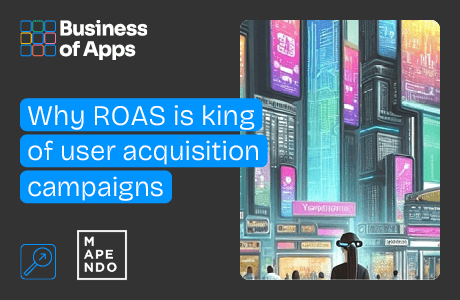Mobile gaming has taken the world by storm, with millions of players engaging in a vast array of games across various genres. Reports suggest that mobile games’ revenues in 2023 will easily surpass 100 billion dollars, keeping a huge lead over game consoles and PCs. This shows that the industry presents incredible opportunities for game developers and publishers to not only create engaging content but also to expand their user bases. One crucial aspect of this expansion is scaling your user acquisition (UA) campaign effectively.
User acquisition is the lifeblood of any mobile game’s success. This process does not only include getting people to download your game, but it also pertains to everything from attracting the right users who will engage with your content to making in-app purchases and establishing brand loyalty. To achieve this, you need a well-structured and scalable user acquisition campaign.
Scaling a mobile game user acquisition campaign could certainly be a challenging step: this is why it is very wise to join forces with the right partners in order to plan out the best possible strategies and to make UA a manageable process. For a UA campaign to be successful, some key steps need to be followed.
Check this out to discover more about mobile games UA and read Mapendo’s success stories with international games.
What DSPs bring to the table of mobile games user acquisition
When scaling your mobile game user acquisition campaign, one of the most crucial decisions to be made is selecting the right User Acquisition partners. Demand-Side Platforms (DSPs) are a popular choice in the mobile gaming industry, and for good reason.
DSPs are technology platforms that allow advertisers to buy advertising space across multiple ad exchanges. They are also able to optimize ad placements in real time.
DSPs can also work alongside platforms such as Google or Facebook, which are vastly used in user acquisition and can present the advertiser with many advantages.
To be able to scale a campaign it is fundamental to have a big reception range. DSPs allow us to reach a vast audience quickly by offering access to a wide range of ad inventory across various ad exchanges.
DSPs can optimize ad placements using advanced algorithms and machine learning technology, with which they become able to analyze user behavior and their performance data. They can also ensure that ads are shown to the best target possible, which is the most engaged audience, improving your ROI. Having large sets of data also becomes useful in decision-making moments, and at the same time it is very important to have a constant exchange of data in both directions, from advertisers to DSPs and vice versa.
DSPs buy ad inventory through real-time bidding exchanges. Even though mobile DSPs pay for ad placements on a CPM (Cost Per Mille) basis, advertisers can negotiate with DSPs in order to pay either CPI (Cost Per Install) or CPA (Cost Per Action).
ROI as the main KPI in mobile gaming user acquisition
At the very beginning of a user acquisition campaign, it is essential to define clear goals and the Key Performance Indicators (KPIs) to look at. This passage is not to be overlooked, as it will be critical for measuring the success of your campaign.
When planning UA strategy, there are usually two broad goals in mind: big volumes of new users and an increase in revenue generated from acquired users. It is vital to set these goals from the beginning and possibly choose which of them has priority over the other.
KPIs are incredibly useful tools to measure and evaluate performance for a specific goal over time. There are many KPIs that could be employed when tracking and optimizing UA, but it is only beneficial and effective to use the ones best suited to the goal the advertiser wants to reach.
In mobile gaming UA, ROI is widely considered the key performance indicator to use to scale UA. ROI stands for Return On Investment, and it helps developers and marketers to assess the effectiveness and profitability of their user acquisition campaigns. ROI measures the revenue generated compared to the cost of acquiring users, meaning that a positive ROI indicates a profitable campaign.
Lately, ROI has become the most relevant and important metric for mobile game developers, as analyzing ROI fluctuations helps in setting and adjusting user acquisition budgets, and ensures that marketing costs are aligned with revenue goals and profitability targets.
Share data about ROI or access/integration to internal BI with UA partners
It is essential to collaborate and share data with UA partners for a successful campaign, as transparency and open communication enable your partners to optimize the UA campaign towards ROI effectively. Sharing data about ROI or providing access to your internal Business Intelligence (BI) systems can be highly beneficial.
- Sharing performance data, including conversion rates, engagement metrics, and revenue generated, with UA partners allows them to adjust their strategies in real time and make data-driven decisions.
- Integrating UA partners’ systems with advertisers’ internal BI systems can streamline and facilitate the process of sharing data. It provides partners with a deeper understanding of the app’s performance and user behavior in real time.
Set targeting for GEOs and platforms
The choice of targets based on geolocation and operating systems for user acquisition in advertising depends on specific business goals, target audience, and budget. As a matter of fact, the choice mostly comes down to money, since every target has a specific cost, due to a series of factors.
- Choosing to target the so-called tier-1 countries, such as North America or Central Europe, would have a bigger impact on initial budgets, but it is more likely to generate revenue than by targeting other areas of the world. This is because in tier-1 countries the market is much more competitive and diversified, so higher advertising costs are expected. On the other hand, choosing to target lower-tier countries will result in cost-effectiveness in the beginning, but with less probability of generating revenue.
- In the same way, a choice must be made upon which operative system to target, always considering the impact it will have on budgets. In particular, iOS users are considered to have higher incomes and are generally richer: this means that there is a bigger probability they would be willing to spend money on an app, and therefore the cost of targeting these users is higher. Conversely, Android users are weighted differently, as they are a supposedly diverse user base, with different habits and generally lower incomes. Thus, targeting this audience will cost much less.
Adopt dynamic CPIs
Cost Per Install (CPI) is a common pricing model in user acquisition campaigns. However, static CPIs may not be suitable when scaling your campaign, as the cost of acquiring users can fluctuate. Adopting dynamic CPIs can help developers manage their budgets more effectively.
Dynamic CPIs adjust based on real-time factors, such as competition, ad performance, and user behavior. This flexibility allows advertisers to allocate their budget more efficiently and stay competitive in the market.
Having a dynamic CPI enables us to immediately modify it and to have an instant impact on ROI, which can help the ongoing campaign. Attention is required though, as adjusting CPI by lowering it in order to increase ROI is not a sustainable choice in the long term: having too low CPIs prevents the acquisition of high-quality users and will eventually affect in-app revenues negatively.
Creatives play a huge role
Creatives are the visual and interactive elements that lure users to install your game. There are several different types of creatives, and all of them are very much used, each of them with its own area of suitability.
Video ads have a high chance of engaging with users by showcasing gameplay and key features of a game and they provide a dynamic way to capture the attention of potential new users.
On a similar note, playable ads allow users to interact with a simpler version of the game in order to convince them to install it. This kind of hands-on experience can significantly boost conversion rates.
What could really be a game changer though, is being able to use multiple creatives’ variations to reach a broader audience. This variation prevents new possible users from getting annoyed or bored by always watching the same creatives.
There can also be an even further step, with the addition of dynamic stacked ad units, a kind of creatives which includes different formats (that can be tested in multiple different combinations) and can very much help towards ROI optimization.
Here you can read about Mapendo’s results with newly released dynamic ad units.
The role of SKOverlay
A very interesting tool that can be potentially used in user acquisition is SKOverlay, a small click-to-install banner that appears at the bottom of other ads. This tool is provided directly by Apple and allows for further personalization of the click-to-install banner when using SKAdNetwork.
SKOverlay offers a very particular function: once clicked on, the app install process begins without opening the store itself and without leaving the publisher app. As a result, the user can continue using their apps without getting annoyed by seeing their experience interrupted.
The employment of SKOverlay has shown to be particularly effective when coming up from the bottom of the screen. This position prevents the whole interface from appearing messy and the user feeling overwhelmed by ads.
Monitoring and optimization are key
Scaling a mobile game user acquisition campaign is an ongoing process and it is essential to monitor and optimize continuously to ensure that a campaign remains efficient and cost-effective.
This can be done by using analytics tools that can monitor ad performance and campaigns in real-time and can identify any trend, anomaly, or area that may be in need of improvement.
Optimization can also be conducted through A/B testing, which is very useful for comparing different ad creatives, targeting options, and bidding strategies. A/B testing is a data-driven approach that can definitely help refine a campaign and get better results.
These mechanisms always allow one to keep a close eye on budgets and allocate resources to the most effective channels and campaigns, so advertisers can adjust their spending based on the performance of each channel employed during UA.
Conclusions
- Scaling a mobile game’s user acquisition campaign requires careful planning, data-driven decision-making, and collaboration with the right partners.
- Partnering with DSPs and setting clear goals and KPIs are the first important steps to take to be able to plan a good ad campaign strategy. In regards to mobile games user acquisition campaigns, ROI is the most efficient KPI.
- After that, it becomes crucial to share data with UA partners and to target the right geolocations and platforms, always keeping an eye on the bigger picture and adjusting and allocating the budget towards those areas that are more in need of changes.
- Good strategies to employ include adopting dynamic CPIs and providing engaging creatives, always remembering that it is essential not to annoy or bore new potential users.
- SKOverlay can be used in UA, as it stands out as a very effective method of ad personalization and has shown promising results.
- Finally, in a constantly evolving and competitive mobile gaming landscape, monitoring and optimizing campaigns can maximize the chances of success and attract and retain a dedicated player base to ensure continuous growth.











